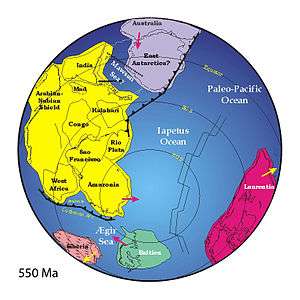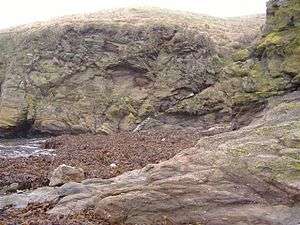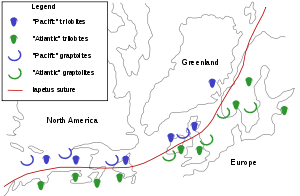Iapetus Ocean
The Iapetus Ocean (pronounced /aɪˈæpɪtəs/)[1] was an ocean that existed in the late Neoproterozoic and early Paleozoic eras of the geologic timescale (between 600 and 400 million years ago). The Iapetus Ocean was situated in the southern hemisphere, between the paleocontinents of Laurentia, Baltica and Avalonia. The ocean disappeared with the Acadian, Caledonian and Taconic orogenies, when these three continents joined to form one big landmass called Euramerica. The "southern" Iapetus Ocean has been proposed to have closed with the Famatinian and Taconic orogenies, meaning a collision between Western Gondwana and Laurentia.

Because the Iapetus Ocean was positioned between continental masses that would at a much later time roughly form the opposite shores of the Atlantic Ocean, it can be seen as a sort of precursor of the Atlantic. The Iapetus Ocean was therefore named for the titan Iapetus, who in Greek mythology was the father of Atlas, after whom the Atlantic Ocean was named.[upper-alpha 1]
Research history

At the start of the 20th century, American paleontologist Charles Walcott noticed differences in early Paleozoic benthic trilobites of Laurentia (such as Olenellidae, the so-called "Pacific fauna"), as found in Scotland and western Newfoundland and those of Baltica (such as Paradoxididae, often called the "Atlantic fauna"), as found in the southern parts of the British Isles and eastern Newfoundland. Geologists of the early 20th century presumed that a large trough, a so-called geosyncline, had existed between Scotland and England in the early Paleozoic, keeping both sides separated.[3]
With the development of plate tectonics in the 1960s, geologists such as Arthur Holmes and John Tuzo Wilson concluded that the Atlantic Ocean must have had a precursor before the time of Pangaea. Wilson also noticed that the Atlantic had opened at roughly the same place where its precursor ocean had closed. This led him to his Wilson cycle hypothesis.[3]
Geodynamic history
Neoproterozoic origin
In many spots in Scandinavia basaltic dikes are found with ages between 670 and 650 million years. These are interpreted as evidence that by that time, rifting had started that would form the Iapetus Ocean.[4] In Newfoundland and Labrador, the Long Range dikes are also thought to have formed during the formation of the Iapetus Ocean.[5] It has been proposed that both the Fen Complex in Norway and the Alnö Complex in Sweden formed as consequence to mild extensional tectonics in the ancient continent of Baltica that followed the opening of the Iapetus Ocean.[6]
The southern Iapetus Ocean opened between Laurentia and southwestern Gondwana (now South America) about 550 Ma in the Ediacaran–Cambrian transition. At the time it did so the Adamastor Ocean further east closed.[7] The opening of the Iapetus Ocean probably postdates the opening of the Puncoviscana Ocean with the Iapetus Ocean being separated from the Puncoviscana Ocean by the ribbon-shaped Arequipa-Antofalla terrane. However, the formation of both oceans seems unrelated.[8]
Paleozoic

Southwest of the Iapetus, a volcanic island arc evolved from the early Cambrian (540 million years ago) onward. This volcanic arc was formed above a subduction zone where the oceanic lithosphere of the Iapetus Ocean subducted southward under other oceanic lithosphere. From Cambrian times (about 550 million years ago) the western Iapetus Ocean began to grow progressively narrower due to this subduction. The same happened further north and east, where Avalonia and Baltica began to move towards Laurentia from the Ordovician (488-444 million years ago) onward.[4]
Trilobite faunas of the continental shelves of Baltica and Laurentia are still very different in the Ordovician, but Silurian faunas show progressive mixing of species from both sides, because the continents moved closer together.[10]
In the west, the Iapetus Ocean closed with the Taconic orogeny (480-430 million years ago), when the volcanic island arc collided with Laurentia. Some authors consider the oceanic basin south of the island arc also a part of the Iapetus, this branch closed during the later Acadian orogeny, when Avalonia collided with Laurentia.
It has been suggested that the southern Iapetus Ocean closed during a continental collision between Laurentia and Western Gondwana (South America). If factual the Taconic orogen would be the northward continuation of the Famatinian orogen exposed in Argentina.[11][upper-alpha 2]
Meanwhile, the eastern parts had closed too: the Tornquist Sea between Avalonia and Baltica already during the late Ordovician,[12] the main branch between Baltica-Avalonia and Laurentia during the Grampian and Scandian phases of the Caledonian orogeny (440-420 million years ago).
At the end of the Silurian period (c. 420 million years ago) the Iapetus Ocean had completely disappeared and the combined mass of the three continents formed the "new" continent of Laurasia,[13] which would itself be the northern component of the singular supercontinent of Pangaea.
See also
- Avalonia – microcontinent in the Paleozoic era
- Baltica – Late-Proterozoic to early-Palaeozoic continent
- Central Iapetus Magmatic Province
- Geologic timescale
- Khanty Ocean – A small Precambrian ocean between Baltica and the Siberian continent
- List of ancient oceans – A list of former oceans that disappeared due to tectonic movements and other geographical and climatic changes
- London-Brabant Massif
- Plate tectonics – The scientific theory that describes the large-scale motions of Earth's lithosphere
- Southern uplands of Scotland
Notes
- The name Iapetus was first used by Harland & Gayer 1972, before that the ocean was referred to as the Proto-Atlantic.[2]
- In other words, what is at present the northern end of the Famatinian orogen would have been connected with what is currently the southern end of the Taconic orogen.
References
- Wells, John (14 April 2010). "Iapetus and tonotopy". John Wells's phonetic blog. Retrieved 21 April 2010.
- Banham, P.H.; Gibbs, A.D.; Hopper, F.W.M. (1979). "Geological evidence in favour of a Jotunheimen Caledonian suture". Nature. 277 (5694): 289–291. Bibcode:1979Natur.277..289B. doi:10.1038/277289a0.
- Dalziel 1997, Review: "Archetypal" and "Alternative" Paleogeographic Scenarios, pp. 18–19
- Torsvik et al. 1996
- Kamo, Sandra L.; Gower, Charles F.; Krogh, Thomas E. (1989). "Birthdate for the lapetus Ocean? A precise U-Pb zircon and baddeleyite age for the Long Range dikes, southeast Labrador". Geology. Geological Society of America. 17 (7): 602. Bibcode:1989Geo....17..602K. doi:10.1130/0091-7613(1989)017<0602:bftloa>2.3.co;2. ISSN 0091-7613.
- Meert, Joseph G.; Torsvik, Trond H.; Eide, Elizabeth A.; Dahlgren, Sven (1998). "Tectonic Significance of the Fen Province, S. Norway: Constraints from Geochronology and Paleomagnetism" (PDF). The Journal of Geology. 106 (5): 553–564. Bibcode:1998JG....106..553M. doi:10.1086/516041.
- Gaucher, Claudio; Frimmel, Hartwig E.; Germs, J.B. (2010). "Tectonic Events and Palaeogeographic Evolution of Southwestern Gondwana in the Neoproterozoic and Cambrian". In Gaucher, Claudio; Sial, Alcides; Haverson, Galen (eds.). Neoproterozoic-cambrian tectonics, global change and evolution: a focus on south western Gondwana. Elsevier. p. 295–316. ISBN 978-0-08-093277-4.
- Escayola P., Mónica; van Staal, Cees R.; Davis, William J. (2011). "The age and tectonic setting of the Puncoviscana Formation in northwestern Argentina: An accretionary complex related to Early Cambrian closure of the Puncoviscana Ocean and accretion of the Arequipa-Antofalla block". Journal of South American Earth Sciences. 32 (4): 438–459. Bibcode:2011JSAES..32..438E. doi:10.1016/j.jsames.2011.04.013.
- Figure based on Windley 1996 and Ziegler 1990
- Cocks & Fortey 1990
- Dalla Salda, Luis H.; Dalziel, Ian W.D.; Cingolani, Carlos A.; Varela, Ricardo (1992). "Did the Taconic Appalachians continue into southern South America?". Geology. 20 (12): 1059–1062. Bibcode:1992Geo....20.1059D. doi:10.1130/0091-7613(1992)020<1059:dttaci>2.3.co;2.
- Torsvik & Rehnström 2003
- See for paleogeographic reconstructions of the collisions for example Stanley 1999, p. 386; Ziegler 1990, pp. 17-19
Literature
- Cocks, L. R. N.; Fortey, R.A. (1990). "Biogeography of Ordovician and Silurian faunas". In McKerrow, W. S.; Scotese, C. F. (eds.). Palaeozoic Palaeogeography and Biogeography. Geological Society of London Memoirs. 12. pp. 97–104. doi:10.1144/GSL.MEM.1990.012.01.08.CS1 maint: ref=harv (link)
- Dalziel, I. W. (1997). "Neoproterozoic-Paleozoic geography and tectonics: Review, hypothesis, environmental speculation". Geological Society of America Bulletin. 109 (1): 16–42. Bibcode:1997GSAB..109...16D. doi:10.1130/0016-7606(1997)109<0016:ONPGAT>2.3.CO;2.CS1 maint: ref=harv (link)
- Harland, W. B.; Gayer, R. A. (1972). "The Arctic Caledonides and earlier Oceans". Geological Magazine. Cambridge University Press (CUP). 109 (4): 289–314. Bibcode:1972GeoM..109..289H. doi:10.1017/s0016756800037717. ISSN 0016-7568.CS1 maint: ref=harv (link)
- Meert, Joseph G.; Torsvik, Trond H. (2003). "The making and unmaking of a supercontinent: Rodinia revisited". Tectonophysics. 375 (1–4): 261–288. Bibcode:2003Tectp.375..261M. doi:10.1016/s0040-1951(03)00342-1. ISSN 0040-1951.CS1 maint: ref=harv (link)
- Stanley, Steven M. (1999). Earth System History. W.H. Freeman. ISBN 978-0-7167-3377-5.CS1 maint: ref=harv (link)
- Torsvik, Trond H.; Rehnström, Emma F. (2003). "The Tornquist Sea and Baltica–Avalonia docking". Tectonophysics. 362 (1–4): 67–82. Bibcode:2003Tectp.362...67T. doi:10.1016/s0040-1951(02)00631-5. ISSN 0040-1951.CS1 maint: ref=harv (link)
- Torsvik, T. H.; Smethurst, M. A.; Meert, J. G.; Van der Voo, R.; McKerrow, W. S.; Brasier, M. D.; Sturt, B. A.; Walderhaug, H. J. (1996). "Continental break-up and collision in the Neoproterozoic and Palaeozoic—a tale of Baltica and Laurentia". Earth-Science Reviews. 40 (3): 229–258. Bibcode:1996ESRv...40..229T. doi:10.1016/0012-8252(96)00008-6.CS1 maint: ref=harv (link)
- Windley, B. F. (1996). The Evolving Continents (3rd ed.). Wiley. ISBN 978-0-471-91739-7.CS1 maint: ref=harv (link)
- Ziegler, Peter A. (1990). Geological Atlas of Western and Central Europe (2nd ed.). Shell Internationale Petroleum Maatschappij B.V. ISBN 978-90-6644-125-5.CS1 maint: ref=harv (link)
External links
- Earth.ox.ac.uk - For more extensive geologic information see Ordovician paleogeography and the evolution of the Iapetus ocean.